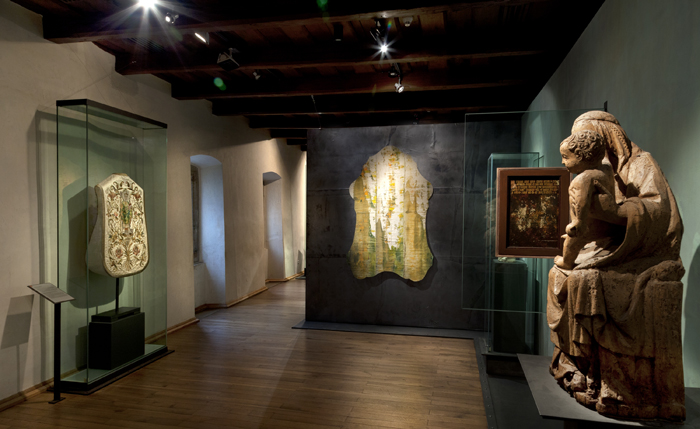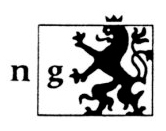The National Gallery in Prague
Convent of St Agnes of Bohemia
Medieval Art in Bohemia and Central Europe
1. November 2013 – 2. February 2014
The paintings by Patrik Hábl, which temporarily found asylum in the permanent exhibition of medieval art from the collections of the National Gallery in Prague in the Convent of St Agnes of Bohemia, originate from 2013. They, nevertheless, share one essential feature with the Gothic panel paintings and sculptures – they, too, had lost their original place of destination and context and moved away from the community for which they were created. They, similarly to the famous Vyšší Brod Altarpiece or the beautiful Resurrection by the Master of the Třeboň Altarpiece, do not fulfil their original liturgical purpose in the gallery.
The place of origination of Háblʼs paintings is, among other things, indicated to an open-eyed visitor by their shape. The seemingly endless abstract dialogue between colours was, during this yearʼs Lent period, defined and outlined by the richly decorated chasuble frames of Baroque altarpieces in the St Salvador (Holy Saviour) Church in Prague. Patrik Hábl at that time executed a series of fifteen paintings which veiled the narrativeness and iconographic exuberance of all the altarpiece canvases in the church. In harmony with the ancient traditions of living out the liturgical year, he filled the St Salvador Church in the period of the approaching Easter with an apt expression of concentration, disengagement, depth and surpassing nature of the Christian message. Háblʼs intervention received a considerably positive reaction from both the regular attendees of the church services and the critical professional public. Two of these Lent “altarpiece canvases”, which again gave way to the dialectic message of the original altarpieces in the new liturgical period, are now confronted with the most beautiful works of Bohemian fine arts dating to the Middle Ages, and can thus evoke as disturbing and inspiring an impression as they once did in the liturgically lively church in the close vicinity of Charles Bridge. And also in the Convent of St Agnes, they transform the commonplace perception of space – this time the space of a gallery. They disrupt the continuity of the carefully composed exhibition, maybe first seeming to be an inappropriate invasion from another time and another world. They raise questions. The original golden frame is missing, the only remaining thing is an imprint of its shape; the paintings are naked, pulled out from their altarpiece architectures, as if they were undressed and merely remained stretched on the black panels as animal skins.
Apart from referring to the non-commonplace, almost tragic character of a gallery presentation of a similarly “uprooted” medieval painting, a character which we sometimes do not even realize under the impression of the beauty of the exhibited works or when reading their art-historical explanations, Háblʼs paintings also open other layers of interpretation. The intervention – it is not only the invasion but also a certain kind of an intercession or support – revives the original perception of the works by the old masters and points out their real, often partially forgotten meanings. The dialogue between the similar fates leads via the dialogue between art forms as far as to revealing the shared timeless task of both the old and the new – to be a window to another world. A medieval painting, an imprint of the absent golden Baroque frame as well as a contemporary abstract painting support and enhance each other under a more concentrated gaze. The new context thus resuscitates and enriches both sides. Contemporary art indeed can chime the art of the old ages, but vice versa is the truth, too. Equally, Háblʼs paintings draw new vitality from their ancient hosts and invite new associations.
And what else than a joy of understanding deeper meanings and revealing new contexts should the permanent exhibition of one of our most beautiful collections of medieval art bring to its visitors?
Curators of the intervention: Jan Klípa and Norbert Schmidt
Organized by: The National Gallery in Prague in cooperation with the Centre for Theology and Art at the Catholic Theological Faculty of the Charles University in Prague.

foto © Národní galerie

